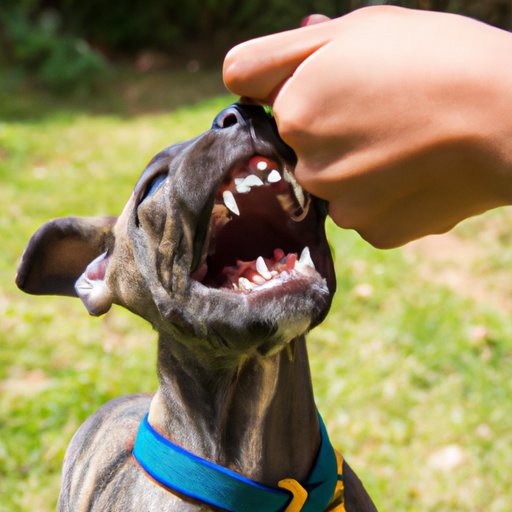
I. Introduction
Welcoming a new puppy into your home is an exciting time, but it comes with its challenges. One of the most common issues that new puppy owners face is nipping and biting behavior. While it may seem harmless at first, it’s critical to train your puppy not to bite and nip. This article provides a comprehensive guide on how to get your puppy to stop biting through positive reinforcement, scheduling, redirection, bite inhibition, and positive play behavior tips.
II. Train Your Puppy Using Positive Reinforcement
Positive reinforcement refers to rewarding good behavior, rather than punishing bad behavior. It’s highly effective in shaping a puppy’s behavior and has long-lasting positive effects. To use positive reinforcement for training your puppy not to bite, start by praising and rewarding them when they don’t nip or bite. Use treats, toys, and verbal cues like “good dog” or “great job” to reinforce good behavior. Consistency is key – rewards should be given immediately after good behavior occurs to reinforce this behavior as desirable.
III. Develop a Consistent Schedule
Having a consistent schedule is critical for puppies, just like it is for young children. A regular routine can help reduce anxiety, develop trust, and prevent unwanted behavior, such as biting. Set a routine for feeding, playtime, rest, and potty breaks. Try to stick to this routine to help your puppy feel secure and avoid creating confusion or distress.
IV. Show Your Puppy What They Can Bite
It’s natural for puppies to chew and bite on things as they explore their new environment. However, it’s essential to teach them what’s acceptable and what’s not. Encourage your puppy to bite on toys and treats that are specifically designed for chewing. Show them how to use these toys and reward them for doing so. Avoid yelling or punishing your puppy for inappropriate chewing or biting. Instead, gently remove them from the situation and redirect them toward appropriate chew toys or treats.
V. Teach Bite Inhibition
Bite inhibition is a vital element of puppy training. It refers to your puppy learning to regulate the force of their bite. It’s essential to teach your puppy this skill for their safety as they become adults. Begin by gently placing your hand in your puppy’s mouth and “ouching” when they bite too hard. Over time, the puppy should learn that biting too hard leads to adverse feedback and will adjust their strength. Be patient and consistent when training your puppy for bite inhibition, and they’ll learn to adjust their bite level correctly.
VI. Don’t Encourage Roughhousing
Roughhousing with your puppy may seem like fun, but it can encourage biting behavior. Instead, choose gentle games like fetch to promote positive play behavior. If your puppy becomes over-excited during playtime, take a break and redirect their attention to something else. Be mindful of their cues and adjust your behavior accordingly.
VII. Conclusion
Training a puppy not to bite is challenging, but using positive reinforcement, developing a consistent schedule, redirecting them to appropriate bite toys, teaching bite inhibition, and promoting positive play behaviors are all effective techniques. Remember to be patient, consistent, and stay positive throughout the training process. With time and patience, your puppy will learn not to bite, becoming a well-behaved and happy dog.
Additional resources for puppy training:
- National Association of Dog Obedience Instructors (www.nadoi.org)
- American Kennel Club (www.akc.org)
- Association of Professional Dog Trainers (www.apdt.




